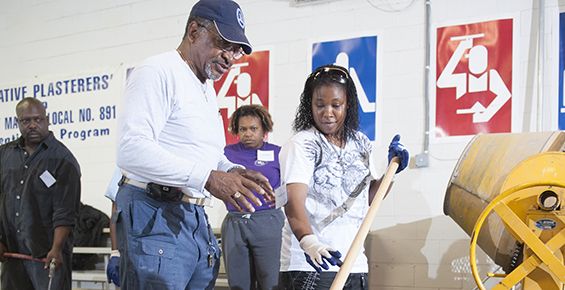June 4, 2018
At a Glance
With this toolkit, training programs for nontraditional jobs can learn how to engage and support women and other underrepresented communities as they seek new, high-potential careers.
Nontraditional jobs hold the promise of new and high-potential career paths. This could mean significant new opportunities for women and others currently underrepresented in nontraditional jobs to access well-paid, career-track jobs that provide economic security and enable them to support themselves and their families. This toolkit is designed to help training programs for nontraditional jobs break through patterns of occupational segregation.
The toolkit’s presentations, trainings, webinars, curriculum guides and modules, briefs, templates, tip sheets, and planning documents are designed to:
- Help workforce development providers assess their capacity for recruiting, assessing, placing, and retaining women in nontraditional occupations
- Assist training providers in developing relevant plans, processes, and curricula for recruiting and retaining women in nontraditional occupations
- Provide guidelines for case management of women and matters related to the unique and wraparound and support services required for women to advance on a career path in nontraditional occupations
- Assist training programs in understanding and linking to organized labor, apprenticeships, and major employers
Using the Toolkit
This toolkit is organized into six sections:
- Outreach and Recruitment of Women
- Assessment and Case Management for Women
- Building Critical Skills of Job Readiness
- Training Design to Facilitate Women’s Success in Apprenticeships
- How to Identify, Address, and Prevent Sexual Harassment
- Health and Safety Issues for Women in Nontraditional Jobs
These resources support the recruitment, training, and retention of women in nontraditional occupations. This toolkit can be used by program planners, managers, and frontline staff conducting outreach and assessment, training, case management, and job development to ensure that each stage of the employment process—from recruitment through retention—looks at how the workplace environment can be responsive to women of many backgrounds and how systems can be created or improved to address the barriers women face. The materials can help build the capacity of organizations to attract women to programs providing education, training, and support services targeted to women’s needs and offer assistance that helps industry partners incorporate policies and practices supporting equity and diversity. The resources also can be used to build on and strengthen existing activities, customize strategies, establish new practices and policies, and deepen effectiveness at serving all participants in an equitable manner.
Ensuring that more women are aware of and supported in entering nontraditional jobs is critical not only to achieving economic equity for women and their families but also to building a competitive workforce. To open their training and career pathways to women, programs must be attuned to and address a range of barriers women face to entering these fields—lack of awareness, sex stereotypes, limited training and work experience, perception of work, myths and stereotypes about women’s work, sex discrimination, and institutional practices directed to men.
Increasing women’s participation in a nontraditional job training program, such as manufacturing, trucking, or construction, must be approached in a strategic and targeted manner, beginning with an outreach and recruitment process that speaks directly with women. This section offers tools to create a good outreach and recruitment plan, including goals and activities.
Sometimes the choices of skills, processes, or criteria used in assessments for selecting job training program participants have a negative impact on women. In addition, the impact of sex stereotypes and learned biases of program intake staff or the assessment teams may limit their ability to see women as competitive candidates for jobs that are primarily dominated by men. Sometimes assessment questions and internalized stereotypes may lead women to screen themselves out of consideration.
Proper assessment is critical for evaluating clients’ core competencies for work readiness. It sets the stage for good case management by identifying at the outset what supportive services beyond the classroom each new client will require in order to enroll in, persist in, and complete a training program—and get and succeed in a new job. This section offers suggestions for reviewing assessment practices with a gender lens and ensuring that assessment helps to identify supportive service needs of clients.
Both employers and the administrators of job training programs typically cite soft skills as more important than job-related skills in determining whether a person succeeds in a job. Ensure that your program builds participants’ work-readiness skills alongside vocational training. Gender inequity and gender differences create distinct job-readiness issues for women. Resources in this section offer suggestions for incorporating gender-related topics and a “gender lens” on work readiness into a training program.
These materials are designed to guide trainers and program providers in developing and delivering job training specifically developed to support and prepare women to be competitive candidates and participants in apprenticeships and jobs. The instructor training addresses why a curriculum focused on women and other underrepresented populations is necessary and how to ensure gender and racial inclusivity, sensitivity, and neutrality practices in teaching methods and program design.
These resources include modules that can be integrated into a general pre-apprenticeship training curriculum. The modules address topics that support the success of women and other underrepresented groups in different industry apprenticeship programs.
Related Content

GreenWays
GreenWays Expanding green job training programs to workers in eight major cities.

A History of Building Workforce Partnerships
A History of Building Workforce Partnerships Yolonda Morrison knew nothing about forging metal or operating massive mobile machinery when she first donned a hard hat at a high-tech titanium manufacturer. The 43-year-old single mother had…

Employer Engagement Toolkit: From Placement to Partners
Employer Engagement Toolkit: From Placement to Partners This toolkit is a guide for training providers, workforce development organizations, community colleges, other educational institutions, and community-based organizations deliberately integrating employer engagement into the core decision making…

Untapped Resources, Untapped Labor Pool: Using Federal Highway Funds to Prepare Women for Careers in Construction
Untapped Resources, Untapped Labor Pool: Using Federal Highway Funds to Prepare Women for Careers in Construction One way to improve women’s economic security is creating sustainable pathways into construction careers—an industry where women are underrepresented.…

Expanding the Path to Apprenticeships to Women and Minority Workers
The value of apprenticeships is even more pronounced when they provide pathways for individuals who face barriers to entering the middle class. How can we make sure that apprenticeships are a real option for workers…